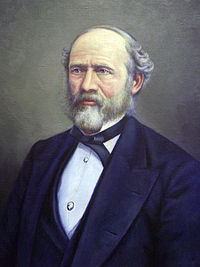Lewis H. Morgan
| Lewis H. Morgan | |
|---|---|

Lewis H. Morgan
|
|
| Born |
November 21, 1818 Aurora, Cayuga County, New York, U.S. |
| Died | December 17, 1881 (aged 63) Rochester, New York, U.S. |
| Occupation | Anthropologist, politician |
| Spouse(s) | Mary Elizabeth Steele |
| Children | Lemuel Morgan, Mary Elisabeth Morgan, Helen King Morgan |
| Parent(s) | Jedediah and Harriet (Steele) Morgan |
Lewis Henry Morgan (November 21, 1818 – December 17, 1881) was a pioneering American anthropologist and social theorist who worked as a railroad lawyer. He is best known for his work on kinship and social structure, his theories of social evolution, and his ethnography of the Iroquois. Interested in what holds societies together, he proposed the concept that the earliest human domestic institution was the matrilineal clan, not the patriarchal family.
Also interested in what leads to social change, he was a contemporary of the European social theorists Karl Marx and Friedrich Engels, who were influenced by reading his work on social structure and material culture, the influence of technology on progress. Morgan is the only American social theorist to be cited by such diverse scholars as Marx, Charles Darwin, and Sigmund Freud. Elected as a member of the National Academy of Sciences, Morgan served as president of the American Association for the Advancement of Science in 1879.
Morgan was a Republican member of the New York State Assembly (Monroe Co., 2nd D.) in 1861, and of the New York State Senate in 1868 and 1869.
According to Herbert Marshall Lloyd, an attorney and editor of Morgan's works, Lewis was descended from James Morgan, brother of Miles, who were Welsh pioneers of Connecticut and Springfield, Massachusetts, respectively. Various sources record that the three sons of William Morgan of Llandaff, Glamorganshire, took passage for Boston in 1636. From there Miles went to Springfield, James to New London, Connecticut and John Morgan to Virginia. Lloyd writes, "From these two brothers [James and Miles] all the Morgans prominent in the annals of New York and New England are believed to be descended." The Morgans to which he refers played a critical part in the foundation of the colonies. During the American Revolutionary War, they were Continentals. Immediately after the war, the Connecticut line, along with many other land-hungry Yankees, migrated into New York State. Following the United States' victory against the British, the new government forced the latter's Iroquois allies to cede most of their traditional lands in New York and Pennsylvania to the US. New York made 5 million of acres available for public sale. In addition, the US government granted some plots in western New York to Revolutionary veterans as compensation for their service in the war.
...
Wikipedia
